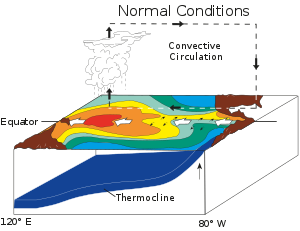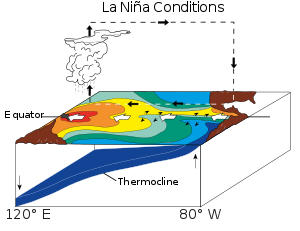According to recent reports, India is experiencing a colder winter than normal. While the cold chills creep up our spine we might forget to question the reason behind this pacific pole phenomenon.
We have the answer right here! This cold is caused due to the north-south winter flow set up by the weather phenomenon known as La Niña.
Generally, El Nino and La Nina occur every 4 – 5 years. El Nino is more frequent than La Nina. Typically, the episodes last for nine to twelve months.
And this year La Niña is going on for a record-breaking third consecutive year!
The forecasts for the year 2023 predict that this fall and winter its companion phenomenon, known as El Niño, will occur with more than a 50% probability.
Let's know the difference between El Niño and La Niña.
Overview of El Niño and La Niña
- While El Niño refers to a band of warmer water spreading from west to east in the equatorial Pacific Ocean, La Niña takes place when the band of water spreads east to west and is cooler.
- Both of these phenomena affect the weather worldwide. Apart from having drastic effects on the weather, it can also cause changes in the economies that depend on rainfall.
- El Niño Southern Oscillation is when El Niño and La Niña make up a cyclical process together.
- An El Niño year creates a global-warming crisis in miniature because the warm water spreads across the tropical Pacific that releases a large amount of heat into the atmosphere.
- There are chances that this year's El Niña could increase the planet’s average surface temperature by more than 1.5° C from pre-industrial levels.
Minus 62 Degrees In Russia: Find The Details On The World’s Coldest City
El Niño and La Niña: Effects on the northern Indian Ocean
- According to reports the El Niño summer has historically tended to produce the largest deficit in the monsoon which will happen post-transition from a La Niña winter.
- This means that pre-monsoon and monsoon circulations tend to be weaker in an El Niño year.
- The change in intensity of winds from the surface to the upper atmosphere is supposed to be weaker as well and can cause enhanced cyclogenesis, or cyclone formation.
- According to reports India is likely to experience a deficit monsoon in 2023 in case an El Niño state does emerge by summer.
- Extreme wet and dry events are predicted in this monsoon deficit. It is likely that there will be isolated pockets of heavy or very heavy rainfall while in other areas the overall seasonal total could be deficient.
El Nino

source: Wikipedia
- The term El Nino means ‘little boy’ or ‘Christ child’ in Spanish.
- It was first recognized by South American fishermen in the early part of the 17th century hence, the phenomenon was named as such.
- Another reason it has this name is that warm waters in the Pacific Ocean tend to occur in December.
- The large-scale ocean-atmosphere climate interaction of El Nino is linked to periodic warming in sea surface temperatures across the central and east-central Equatorial Pacific.
- It is associated with high pressure in the western Pacific.
El Nino: Affects On India
El Nino adversely affects the Indian monsoons and hence, agriculture in India.
- When there is no El Nino and it is a normal monsoon year the pressure distribution causes the coast of Peru in South America to have a higher pressure than the region near northern Australia and South East Asia.
- While the Indian Ocean is warmer than the adjoining oceans it has relatively lower pressure.
- Due to this, the moisture-laden winds move from near the western Pacific to the Indian Ocean.
- The moisture-laden winds move further from the ocean to the lands as the pressure on the landmass of India is lower than on the Indian Ocean.
- If this normal pressure distribution is affected for some reason, the monsoons are affected.
Impacts of El Nino?
- The El Nino causes the cool surface water off the Peruvian coast to go warm.
- The normal trade winds get lost or reverse their direction as the water is warm.
- The flow of moisture-laden winds is directed toward the coast of Peru from the western Pacific the region near northern Australia and South East Asia which causes heavy rains in Peru during the El Nino years and the Indian subcontinent does not have normal monsoon rains.
- The larger the temperature and pressure difference, the larger the rainfall shortage in India.
List Of Top Ten Coldest Places In India
La Nina

Source: Wikipedia
- The term La Nina means ‘little girl’ in Spanish. It is also called El Viejo which means cold event.
- Unlike normal monsoons, water temperature in the Eastern Pacific gets colder when La Nina occurs.
- There is a strong high pressure over the eastern equatorial Pacific due to this occurring.
- Now, there is low pressure in the Western Pacific and off Asia.
- Drought in Peru and Ecuador, heavy floods in Australia, high temperatures in Western Pacific, and the Indian Ocean, off the Somalian coast, and good monsoon rains in India are caused due to La Nina.
- A La Nina is beneficial for the Indian monsoon.
Niagra Falls Turns Into A Winter Wonderland: All You Need To Know
El Nino and La Nina Effects on India
This is because in general, an El Nino means lesser than average rains for India due to which, out of the 13 droughts that India faced, 10 have been during El Nino years and one during a La Nina year since 1950.
Indian agriculture is heavily dependent on the monsoons and because of this, lesser rainfall during the monsoons generally translates to below-average crop yields.
ALSO READ|What Is The Difference Between Celsius And Fahrenheit?
What is the Difference Between Bison and Buffalo?
Ice Storm In The US Leave Thousands Without Power In Texas, Check Details Here
Comments
All Comments (0)
Join the conversation